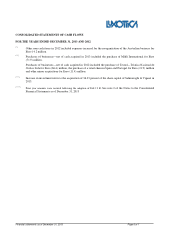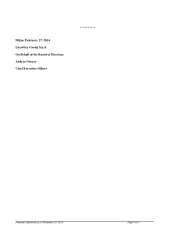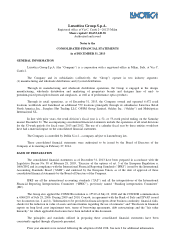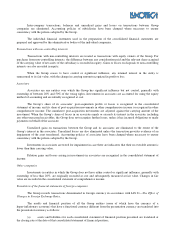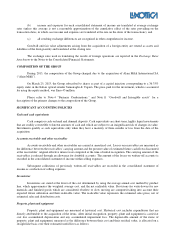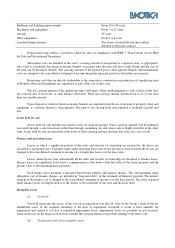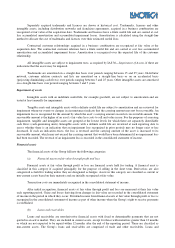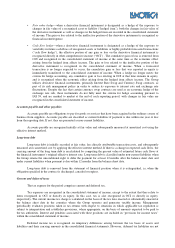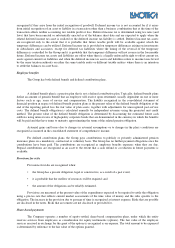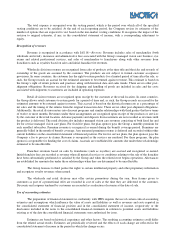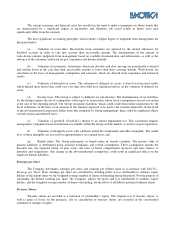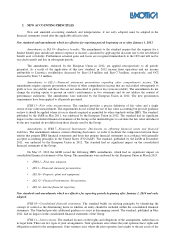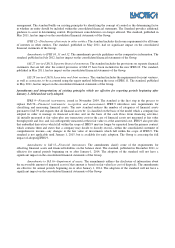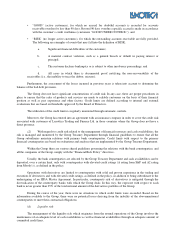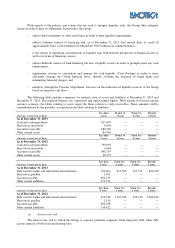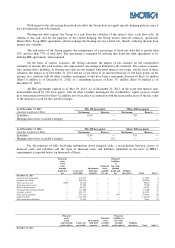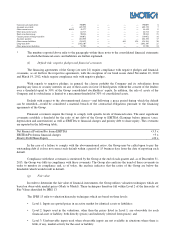LensCrafters 2013 Annual Report Download - page 106
Download and view the complete annual report
Please find page 106 of the 2013 LensCrafters annual report below. You can navigate through the pages in the report by either clicking on the pages listed below, or by using the keyword search tool below to find specific information within the annual report.
• Fair value hedge—when a derivative financial instrument is designated as a hedge of the exposure to
changes in fair value of a recognized asset or liability (“hedged item”), both the changes in fair value of
the derivative instrument as well as changes in the hedged item are recorded in the consolidated statement
of income. The gain or loss related to the ineffective portion of the derivative instrument is recognized as
financial income/expense.
• Cash flow hedge—when a derivative financial instrument is designated as a hedge of the exposure to
variability in future cash flows of recognized assets or liabilities or highly probable forecasted transactions
(“cash flow hedge”), the effective portion of any gain or loss on the derivative financial instrument is
recognized directly in other comprehensive income (“OCI”) . The cumulative gain or loss is removed from
OCI and recognized in the consolidated statement of income at the same time as the economic effect
arising from the hedged item affects income. The gain or loss related to the ineffective portion of the
derivative instrument is recognized in the consolidated statement of income. When a forecasted
transaction is no longer expected to occur, the cumulative gain or loss that was reported in equity is
immediately transferred to the consolidated statement of income. When a hedge no longer meets the
criteria for hedge accounting, any cumulative gain or loss existing in OCI at that time remains in equity,
and is recognized when the economic effect arising from the hedged item affects income. The Group
utilizes derivative financial instruments, primarily Interest Rate Swap and Currency Swap contracts, as
part of its risk management policy in order to reduce its exposure to interest rate and exchange rate
fluctuations. Despite the fact that certain currency swap contracts are used as an economic hedge of the
exchange rate risk, these instruments do not fully meet the criteria for hedge accounting pursuant to
IAS 39, and are marked to market at the end of each reporting period, with changes in fair value are
recognized in the consolidated statement of income.
Accounts payable and other payables
Accounts payable are obligations to pay for goods or services that have been acquired in the ordinary course of
business from suppliers. Accounts payable are classified as current liabilities if payment is due within one year or less
from the reporting date. If not, they are presented as non-current liabilities.
Accounts payable are recognized initially at fair value and subsequently measured at amortized cost using the
effective interest method.
Long-term debt
Long-term debt is initially recorded at fair value, less directly attributable transaction costs, and subsequently
measured at its amortized cost by applying the effective interest method. If there is a change in expected cash flows, the
carrying amount of the long term debt is recalculated by computing the present value of estimated future cash flows at
the financial instrument’s original effective interest rate. Long-term debt is classified under non-current liabilities when
the Group retains the unconditional right to defer the payment for at least 12 months after the balance sheet date and
under current liabilities when payment is due within 12 months from the balance sheet date.
Long-term debt is removed from the statement of financial position when it is extinguished, i.e. when the
obligation specified in the contract is discharged, canceled or expires.
Current and deferred taxes
The tax expense for the period comprises current and deferred tax.
Tax expenses are recognized in the consolidated statement of income, except to the extent that they relate to
items recognized in OCI or directly in equity. In this case, tax is also recognized in OCI or directly in equity,
respectively. The current income tax charge is calculated on the basis of the tax laws enacted or substantially enacted at
the balance sheet date in the countries where the Group operates and generates taxable income. Management
periodically evaluates positions taken in tax returns with respect to situations in which applicable tax regulation is
subject to interpretation and establishes provisions, where appropriate, on the basis of amounts expected to be paid to
the tax authorities. Interest and penalties associated with these positions are included in “provision for income taxes”
within the consolidated statement of income.
Deferred income tax is recognized on temporary differences arising between the tax bases of assets and
liabilities and their carrying amounts in the consolidated financial statements. However, deferred tax liabilities are not


